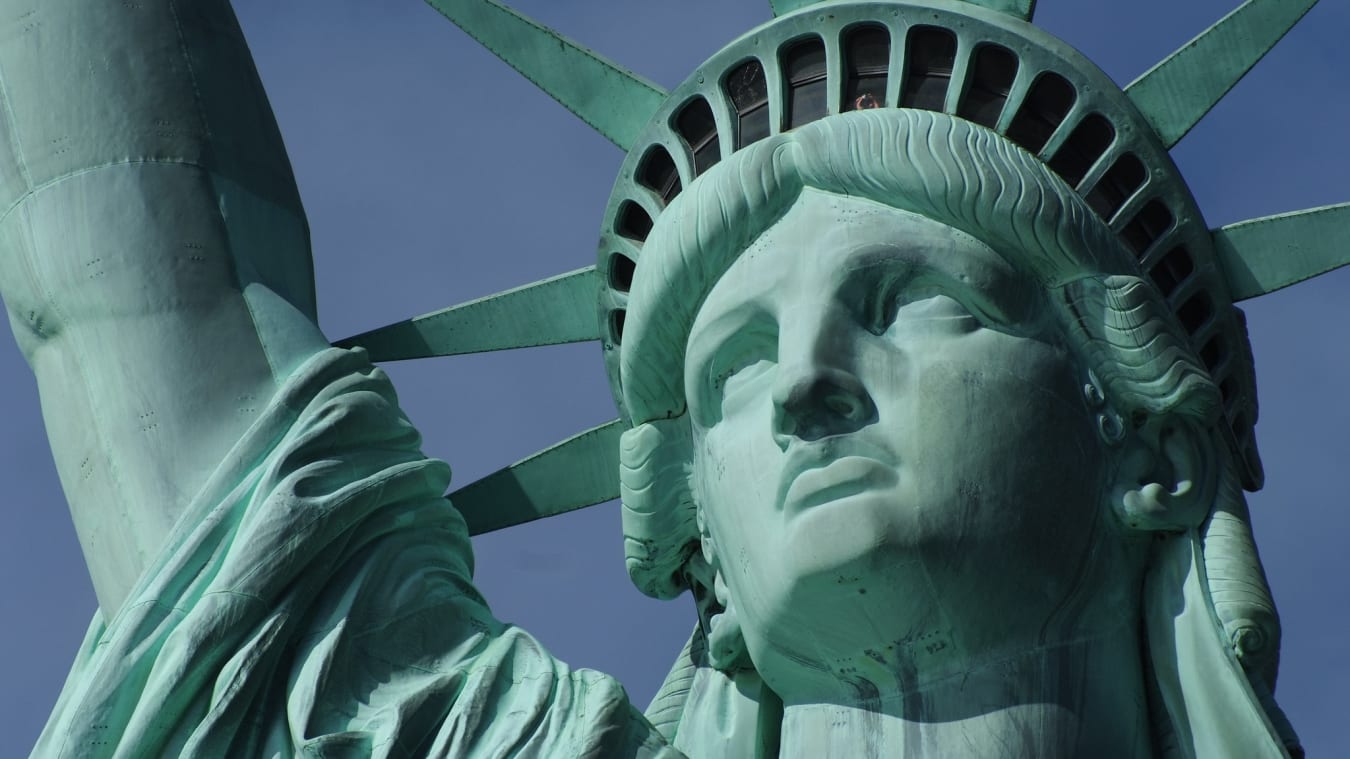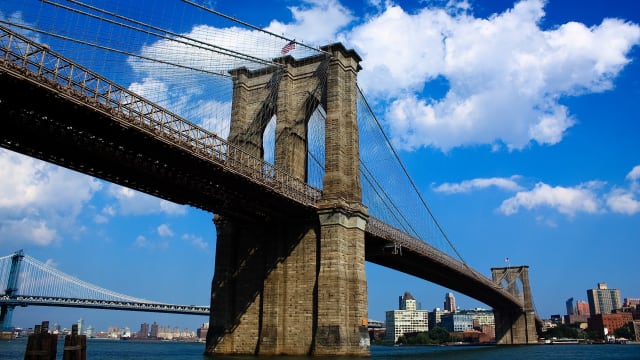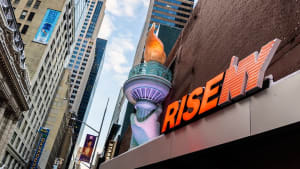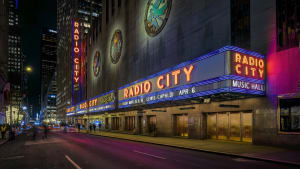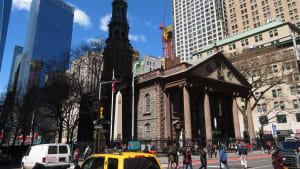The Statue of Liberty
Delve into the world of the Statue of Liberty, America's towering symbol of freedom, and explore this colossal monument's profound history and all it has to offer.
The Statue of Liberty in a Nutshell
Location: Liberty Island, accessible via Battery Park in New York or Liberty State Park in New Jersey.
Transportation: Ferries available from both locations; nearest subway stations to Battery Park include South Ferry and Bowling Green.
Tickets: Advance purchase recommended; options include ferry, pedestal, and crown access. Book here .
Visiting Hours: From 9:30 AM to 5 PM daily, except for Thanksgiving and Christmas
The Statue of Liberty, an enduring symbol of freedom and democracy, was gifted by France and dedicated in 1886. It stands on Liberty Island in New York Harbor, serving as a welcoming sight to arrivals from abroad.
The statue’s design, featuring elements like the seven spikes on the crown representing the world’s seven seas and the shackles and chains at its feet symbolizing the overthrow of oppression, encapsulates its message of liberty and enlightenment.
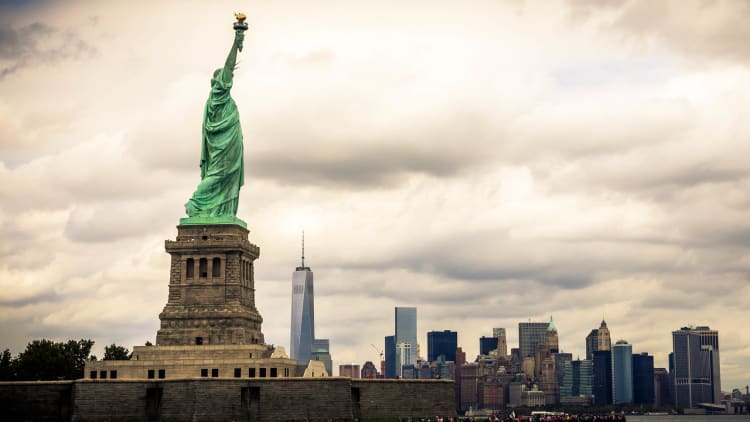
At 305 feet, it was the tallest iron structure at the time of its dedication. The exterior is coated in sheets of copper, now green due to over a century of weathering, which was originally a dull brown. This colossal monument is not only a testament to the engineering marvels of its age but also a beacon for the millions who came to America in search of a new beginning.
From the torch held high, welcoming all, to the broken shackles at her feet, the Statue of Liberty is packed with symbolism and history.
Whether you’re marveling at the massive monument up close, exploring the accompanying museum, or simply taking in the panoramic views of the surrounding cityscape, there’s no shortage of things to see and do. And with the pivotal fundraising efforts by Joseph Pulitzer, which allowed the pedestal to be built, the statue stands as a monument to both American and French collaboration and public spirit.
Brief History
The Statue of Liberty’s journey from an idea to a physical colossus on Liberty Island encapsulates a story of international friendship and shared ideals. Proposed by Édouard de Laboulaye in 1865 to commemorate American independence and the abolition of slavery, the statue was a gift from the French people, designed by sculptor Frédéric-Auguste Bartholdi.
The statue’s design embodies powerful symbols: its crown’s spikes represent the sun’s rays extending to the world, while the tablet in her hand marks the date of America’s independence, July 4, 1776.

The statue was completed in France in 1884 and shipped to the USA in pieces. Its assembly on what was then called Bedloe’s Island, and the construction of its pedestal—funded by donations solicited by Joseph Pulitzer through his newspaper—were monumental tasks, emblematic of the collaborative spirit they intended to celebrate.
Dedicated by President Grover Cleveland in 1886, it has since undergone several renovations, including a significant restoration in 1984 when the original torch was replaced with a gold-plated replica to preserve the statue’s structural integrity and enhance its symbolic message of enlightenment.
Practical Information
Visiting the Statue of Liberty is a highlight for any trip to New York City, offering insights into American history and spectacular views of the surrounding harbor. Here’s essential information to plan your visit efficiently.
Location
The Statue of Liberty is located on Liberty Island, while Ellis Island lies nearby, both rich with historical significance.
The islands are accessible from Battery Park in New York or Liberty State Park in New Jersey.
How to Get There
Navigating to the Statue of Liberty is straightforward, with multiple transport options available:
Ferry
The primary access to the island is by ferry, available from Battery Park City or Liberty State Park. Ferries run at regular intervals throughout the day, providing not only transport but also stunning views of New York Harbor and the skyline.
To get to Battery park you can take the subway:
- 1 train to South Ferry Station
- 4 or 5 trains to Bowling Green
- R or W trains to Whitehall Street
If you prefer to get there by bus, the following routes will take you:
- M55, M15, M15-SBS, M20: to South Ferry
- BM series & X series (BM1, BM2, BM3, BM4, X1, X3, X4, X8, X14, X15): to State Street and Battery Place
- X10, X11, X12, X17, X19: to Battery Place
For more information, you might want to check out our articles about New York City transportation or figuring out the best MetroCard for your needs.
Tickets
Advance ticket purchases are essential, especially for pedestal and crown access, which are limited. Book with us to ensure a hassle-free visit.
Why Book a Tour?
Booking a tour enhances your experience, providing structured insights and historical context that enrich your visit. Tours include convenient ferry services and can be combined with trips to nearby Ellis Island, offering a fuller understanding of the immigrant experience.
Special Tours
Consider unique tour options such as helicopter rides for aerial views, or a dinner cruise for a more relaxed sightseeing experience, each offering a unique perspective of New York City and the Statue of Liberty.
Opening Times
The Statue of Liberty is open daily from 9:30 AM to 5 PM, except for Thanksgiving and Christmas.
The last admission to the pedestal is at 3:30 PM, but times may extend up to 5:00 PM during peak season.
Best time to visit
It’s better to plan your visit for early morning or late afternoon in order to avoid the crowds.
What to See and Do at the Statue of Liberty
The Statue of Liberty offers various points of interest from the base to the crown:
Exploring the Pedestal and Museum
The pedestal offers a robust view of the harbor and houses a museum with exhibits on the statue’s symbolism, history, and construction. The museum’s content deepens the appreciation for the efforts behind this iconic figure.
Pedestal Access
Reservation for pedestal access is recommended, especially during peak tourist seasons. The pedestal’s top affords one of the best views of the harbor and skyline.
Visiting the Crown
Climbing to the crown is a rigorous but rewarding experience, offering unmatched views and a personal encounter with this monumental icon.
Health and Safety
The climb to the crown is strenuous; visitors with health issues should consider this before booking. Safety measures are in place to ensure a secure experience.

Dining and Amenities
Dining options are limited to what you bring, as security measures restrict food and beverage entry. Locker facilities are available for storing larger items.
Ellis Island Complementary Visit
A trip to the Statue of Liberty is incomplete without a visit to Ellis Island, accessible by the same ferry service.
The island’s museum offers insights into the immigrant experience, pivotal to understanding the statue’s historical context.
Tips to Visit the Statue of Liberty
Maximize your experience with these tips:
- Early Arrival: Arrive at Battery Park or Liberty State Park early in the morning to avoid crowds. This is particularly beneficial if you’re aiming to take serene photos of the statue against a less crowded backdrop. Early mornings offer softer light which is perfect for photography.
- Sunrise and Sunset: Schedule your ferry ride and visit to coincide with sunrise or sunset. The dramatic lighting conditions during these times provide a breathtaking backdrop against the Statue and the city skyline, ideal for striking photography.
- Ferry Views: For the best photographic opportunities during your ferry ride, position yourself on the right side of the ferry as you approach Liberty Island. This spot offers unobstructed views of the Statue from a distance, allowing for panoramic shots.
- Base Views: For close-up shots of the statue, the area around the base is ideal. This location allows for detailed photographs of the pedestal and the structure itself.
- Pedestal Views: Climbing to the pedestal provides a unique vantage point for photos with the cityscape in the background.
- Battery Park Views: For a comprehensive view that includes the statue’s pedestal and base, position yourself at Battery Park in Lower Manhattan. This location offers a distant, yet complete view of the Statue, perfect for capturing its full stature.
- Inside the Museum: Inside the Statue of Liberty Museum, aim to capture the Torch exhibit. This provides a stunning interior perspective and is a must-shoot for visitors.
- Drone Photography: If you’re using a drone, be mindful of air space regulations. Drones must stay at least 400 feet away from the boundaries of the landmark. This regulation helps maintain safety and security for all visitors.
- Comfort and Protection: Wear comfortable shoes suitable for extensive walking. The grounds and the climb to the crown can be quite strenuous. Also, bring sunscreen and a hat to protect against the sun, especially during the summer months.
- Visit Governors Island: Incorporate a trip to Governors Island into your itinerary during the warmer months. The island offers additional sightseeing opportunities, including unique picnic spots with fantastic views of the Statue of Liberty.
- Fort Wood: Consider lying down on top of Fort Wood for a distinct angle of the statue, capturing both the pedestal and its iconic pose in one frame.
- From the Crown: If you make the climb, the crown itself provides a narrow, framed view of the surrounding land and waterscape, which can make for dramatic compositions.
Accessibility Details
The Statue of Liberty is dedicated to providing an accessible and enjoyable experience for all visitors, with several enhancements to facilitate accessibility:
- 1984 Renovations: Major accessibility improvements were made during the 1984 renovations initiated by the Access-Ability Committee. These improvements included installing elevators and ramps, making the pedestal and museum accessible to those who cannot use the stairs.
- Elevator Access: Elevators are available for visitors with mobility issues to access the pedestal, where they can enjoy views and visit the museum which details the statue's history and symbolism.
- Service Animals: Service animals are permitted on Liberty Island and inside the Statue of Liberty to assist visitors with disabilities.
- Audio Tours: Audio tours are available, including versions with descriptive commentary for visitors with visual impairments.
- Facilities Accessibility: All visitor facilities, including restrooms, and gift shops, are wheelchair accessible.
- Tactile Models: Tactile models of the Statue are available at the museum for visitors with visual impairments to experience the shape and texture of the monument.
- Assistance Availability: Accessibility specialists are on hand to assist visitors in navigating the facilities and to provide any necessary services to enhance their visit.
Crown Accessibility
While the Statue of Liberty is equipped with numerous accessibility features, including elevators to the pedestal, ramps, and tactile models, please note that access to the crown is not available via wheelchair.
The crown can only be reached by climbing a narrow and steep staircase of 377 steps, which may not be suitable for visitors with mobility impairments. We recommend enjoying the extensive exhibits in the pedestal and the museum, which are fully accessible and offer a wealth of information about the history and significance of the Statue.
Frequently Asked Questions
-
Access to the crown of the Statue of Liberty is available, but you must book in advance due to the limited capacity.
It’s a popular attraction, and the narrow staircase to the crown does not accommodate large numbers at one time, making reservations essential.
-
The most straightforward way to reach the Statue of Liberty is by ferry from Battery Park in Manhattan or Liberty State Park in New Jersey.
These ferries provide direct access to Liberty Island and are the only means of transportation available to the public.
-
Food options on Liberty Island are limited, so it is advisable to bring your own water and snacks.
There are some vending machines and a small café available, but bringing your own refreshments can make your visit more comfortable and flexible.
-
Comfortable walking shoes are strongly recommended due to the significant amount of walking involved on Liberty Island and Ellis Island.
Weather-appropriate clothing should also be considered to enhance your experience, depending on the season of your visit.
-
Yes, significant accessibility improvements have been implemented at the Statue of Liberty, including the installation of elevators and ramps, making the pedestal and museum accessible to visitors with mobility issues.
These facilities ensure that everyone can enjoy the visit. The crown, however, is not accessible to people in wheelchairs.
-
All backpacks, large bags, and food items must be stored in lockers before entering the Statue of Liberty for security reasons.
These lockers are available at the security screening facilities, ensuring that you have a safe and unencumbered visit.
-
A typical visit to the Statue of Liberty, including the ferry ride to and from Liberty Island, usually takes about 2 to 3 hours.
This duration allows ample time to explore the statue’s pedestal, museum, and the grounds of Liberty Island at a leisurely pace.
-
Visiting the Statue of Liberty early in the morning or late in the afternoon can help you avoid the larger crowds that form during peak hours, which typically are around midday.
Less crowded times can provide a more relaxed and enjoyable experience.
-
Photography is permitted at the Statue of Liberty; however, tripods and professional photography equipment might be restricted, especially inside the monument.
Handheld cameras and cell phones are ideal for capturing your visit.
Where to Stay in Lower Manhattan
While there are no accommodations on Liberty Island itself, nearby areas provide numerous options ranging from luxury hotels to budget-friendly lodgings, all within easy reach of Battery Park for your Statue of Liberty visit.
Staying in Lower Manhattan offers convenience and access to a wide array of attractions.This location not only simplifies travel plans but also places you at the heart of New York City’s vibrant historical and cultural scenes.
More Monuments & Landmarks in New York City
Exploring New York City’s monuments and landmarks provides a deeper understanding of its rich history and dynamic culture.
We recommend booking guided tours for an enriched experience, especially for iconic sites like the Statue of Liberty, the Empire State Building and newly opened attractions that offer unique perspectives of the city.
Other Nearby Attractions
Liberty Island’s location makes it a perfect starting point for exploring Lower Manhattan’s rich array of sites:
Ellis Island
The museum on Ellis Island offers a profound journey through the history of America’s immigrants with its extensive exhibits.
It allows visitors to explore the personal stories and artifacts of those who came through Ellis Island, providing a powerful insight into the formation of modern America.
The museum on Ellis Island offers a profound journey through the history of America’s immigrants with its extensive exhibits.
It allows visitors to explore the personal stories and artifacts of those who came through Ellis Island, providing a powerful insight into the formation of modern America.
Governor’s Island
Governor’s Island is a peaceful retreat from the hustle and bustle of city life, located just a short ferry ride from Manhattan.
It offers lush green spaces, historic buildings, and panoramic views of the Statue of Liberty and the Manhattan skyline, making it a perfect spot for relaxation and photography.
Governor’s Island is a peaceful retreat from the hustle and bustle of city life, located just a short ferry ride from Manhattan.
It offers lush green spaces, historic buildings, and panoramic views of the Statue of Liberty and the Manhattan skyline, making it a perfect spot for relaxation and photography.
9/11 Memorial & Museum
The 9/11 Memorial & Museum stands as a solemn tribute to the resilience and courage of New Yorkers following the tragic events of September 11, 2001.
The museum’s exhibits detail the timeline of the attacks and offer narratives from survivors and rescuers, providing visitors with a deeply moving experience.
View details
The 9/11 Memorial & Museum stands as a solemn tribute to the resilience and courage of New Yorkers following the tragic events of September 11, 2001.
The museum’s exhibits detail the timeline of the attacks and offer narratives from survivors and rescuers, providing visitors with a deeply moving experience.
One World Observatory
The One World Observatory is situated atop the One World Trade Center, known as the tallest building in the Western Hemisphere.
It offers visitors breathtaking views of New York City’s skyline, rivers, and beyond from an impressive height of over 1,250 feet.
View details
The One World Observatory is situated atop the One World Trade Center, known as the tallest building in the Western Hemisphere.
It offers visitors breathtaking views of New York City’s skyline, rivers, and beyond from an impressive height of over 1,250 feet.
One World Trade Center
The One World Trade Center, also known as the Freedom Tower, rises above Lower Manhattan as a beacon of resilience and hope.
This architectural marvel not only dominates the skyline but also symbolizes the nation’s recovery from the 9/11 attacks.
The One World Trade Center, also known as the Freedom Tower, rises above Lower Manhattan as a beacon of resilience and hope.
This architectural marvel not only dominates the skyline but also symbolizes the nation’s recovery from the 9/11 attacks.
The Battery
The Battery, located at the southern tip of Manhattan, offers expansive views of New York Harbor, the Statue of Liberty, and Ellis Island.
It’s a historic public park where visitors can stroll along the waterfront promenades, enjoy the gardens, and visit monuments and memorials.
The Battery, located at the southern tip of Manhattan, offers expansive views of New York Harbor, the Statue of Liberty, and Ellis Island.
It’s a historic public park where visitors can stroll along the waterfront promenades, enjoy the gardens, and visit monuments and memorials.
Brooklyn Bridge
Walking across the Brooklyn Bridge provides a unique perspective of New York City’s skyline and the East River below.
This iconic bridge connects Manhattan and Brooklyn and is a favorite for both locals and tourists for its impressive architectural beauty and panoramic views.
View details
Walking across the Brooklyn Bridge provides a unique perspective of New York City’s skyline and the East River below.
This iconic bridge connects Manhattan and Brooklyn and is a favorite for both locals and tourists for its impressive architectural beauty and panoramic views.
